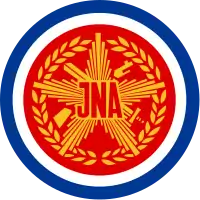List of ships of the Yugoslav Navy
The Yugoslav Navy (Jugoslavenska ratna mornarica; JRM) was the naval branch of the Yugoslav People's Army (Jugoslavenska narodna armija; JNA). Organized as a coastal defence force with the main task of preventing enemy landings on its long and indented coastline, the navy's inventory reflected its foreign relations as well as the growing capabilities of its domestic shipyards and scientific institutions. The period immediately after the end of the Second World War was marked by relying on equipment that was captured, salvaged or obtained from the Western Bloc through reparations or lend-lease programs.[1][2][3]
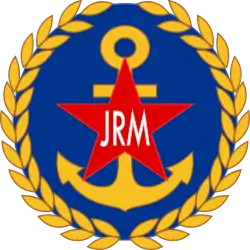
Improved relations with the Soviet Union after Stalin's death meant the acquisition of Eastern military equipment was once again possible. This was soon after realized with torpedo and missile boats of Soviet origin being commissioned with the JRM. The 1960s and 1970s marked the start of a period of reliance on indigenous designs. Domestic naval programs developed by the Brodarski Institut from Zagreb and built in Yugoslav Shipyards included submarines, frigates, patrol boats, missile boats as well as other support ships, with some of them being exported to other countries.[3][4]
The JRM came to its de facto end in 1991 with the escalation of the Croatian War of Independence. The Navy was engaged in imposing a naval blockade of Croatia which culminated in November with the Battle of the Dalmatian Channels. Having lost the majority of its naval infrastructure which was located in the now independent Croatia, the fleet eventually retreated to Boka Kotorska, Montenegro where it was officially disbanded in early 1992 with the remaining ships being commissioned with the new Navy of the Federal Republic of Yugoslavia. The FR Yugoslav Navy included around 80% of the JRM pre-war fleet, with the remaining 20% being lost or captured by Croatian Forces.[3]
Submarines
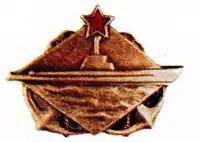
The JRM maintained a submarine force throughout its existence. The first submarines to be commissioned were three submarines captured or returned after the Second World War. Starting with the 1950s and the Sutjeska-class Yugoslavia operated domestically built submarines. The Heroj-class marked a significant technological leap in Yugoslav shipbuilding capabilities with the Brodogradilište specijalnih objekata (Special objects shipyard) in Split becoming the shipyard where all of the remaining boats would eventually be built. All submarines with the exception of Mališan and the Heroj-class boats were named after rivers in Yugoslavia.[5][6]
The last class of Yugoslav submarines was the Una-clas midget submarines which, unlike their larger predecessor, did not carry any torpedo armament and were designed for covert special operations. A new class of larger submarines armed with torpedoes and anti-ship missiles, dubbed the Lora-class or Project B-73, was planned but wasn't started due to the subsequent Breakup of Yugoslavia. By 1991 the JRM operated eleven submarines homeported in the Lora Naval Base in Split. With the start of the Croatian War of Independence all except one Una-class were relocated to Montenegro where they were commissioned with the FR Yugoslav Navy.[5]
| Class | Image | Type | Boats | Shipyard | History | Fate |
|---|---|---|---|---|---|---|
.jpg.webp) |
Mališan (P-901) | Former Italian CB-20. Captured by Yugoslav Partisans in 1945 and commissioned as Mališan (P-901).[8] | Decommissioned in the early 1950s. Donated to the Technical Museum in Zagreb in 1959.[8] | |||
| Tara (P-801) | Former Royal Yugoslav Navy boat.[9] | Stricken in 1954.[9] Deleted in 1958.[3] | ||||
| Sava (P-802) | Former Regia Marina boat. Sunk in 1944. Raised by Yugoslav Forces after the war and commissioned as Sava.[11] | Deleted in 1971.[12] | ||||
| Sutjeska (P-811) Neretva (P-812) |
First domestically built submarine class.[5] | Decommissioned during the 1980s.[13][5] | ||||
| Heroj (P-821) Junak (P-822) Uskok (P-823) |
Completed during the late 1960s.[14] | Relocated to Montenegro at the start of the war.[15] | ||||
| Sava (P-831) Drava (P-832) |
Completed during the late 1970s and early 1980s.[16] | Relocated to Montenegro at the start of the war.[15] | ||||
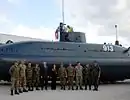 |
Tisa (P-911) Una (P-912) Zeta (P-913) Soča (P-914) Kupa (P-915) Vardar (P-915) |
Completed during the late 1980s. Last generation of Yugoslav submarines.[17] | Soča captured by Croatian Forces and commissioned with the Croatian Navy as Velebit.
The rest relocated to Montenegro.[15] |
Destroyers
| Class | Image | Type | Boats | Shipyard | History | Fate |
|---|---|---|---|---|---|---|
| Split (R-11) | Laid down in 1939 for the Royal Yugoslav Navy.[18] | Stricken in 1984. Scrapped in 1986.[19] | ||||
| Kotor (R-21) Pula (R-22) |
Acquired from the Royal Navy in October 1956. | Kotor sold for breaking up in 1971. Pula stricken the same year, sold for breaking up in 1972.[20] |
Destroyer escorts
| Class | Image | Type | Boats | Shipyard | History | Fate |
|---|---|---|---|---|---|---|
| Triglav (RE-51) Biokovo (RE-52) |
|
Former Regia Marina ships transferred to Yugoslavia in 1949 as war reparation.[13] | Decommissioned in 1971.[13] | |||
| Durmitor (RE-53) Učka (RE-54) |
Durmitor is a former Regia Marina ship transferred to Yugoslavia in 1949 as war reparation. Učka was damaged while being built at Rijeka. Later rebuilt and completed by Yugoslavia. |
Frigates
| Class | Image | Type | Boats | Shipyard | History | Fate |
|---|---|---|---|---|---|---|
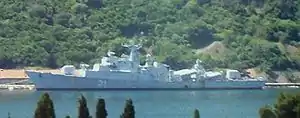 |
Split (VPBR-31) Koper (VPBR-32) |
Acquired from the USSR; Split in 1980 and Koper in 1982.[24] | Relocated to Montenegro at the start of the war.[15] | |||
| Kotor (VPBR-33) Pula (VPBR-34) |
Yugoslav built design based on the Koni-class.[12] | Relocated to Montenegro at the start of the war.[15] |
Corvette
| Class | Image | Type | Boats | Shipyard | History | Fate |
|---|---|---|---|---|---|---|
 |
Partizanka | Transferred to Yugoslavia from the RN on 11 January 1944. Commissioned under the name Nada.[26][9] Renamed Partizanka on 17 November 1945.[6] | Returned to Great Britain in 1948/49.[26][9] |
Fast attack craft
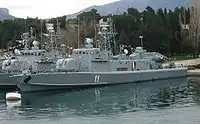
The JRM operated a large number of fast attack craft, commissioning both torpedo and missile boats of different origin. One of the first torpedo boats to enter service with the JRM after the war were eight American PT boats built by Higgins which received designations from MT1 to MT8. Starting with 1951 up to 1960, Yugoslav shipyards, mainly on the island of Korčula, constructed somewhere between 75 and 96 Higgins torpedo boats, with sources being conflicting regarding the exact number. In the early 1960s a number of them were converted to motor gun boats by removing the torpedo tubes. The last Higgins hulls were deleted by 1979. Improved relations with the Soviet Union from the 1960s made buying eastern military equipment once again possible; acquisition of ten Osa I-class missile boats started in 1965 becoming the first ships of the Yugoslav Navy to be armed with anti-ship missiles. Four Shershen-class torpedo boats were commissioned around the same time with ten additional boats being licence built at the Kraljevica Shipyard.[27][25][4]
The 1970s saw the introduction of six Končar-class missile boats featuring a mixture of Soviet and Swedish weaponry. At the time of the escalation of the Croatian War of Independence, the first ship of a new class of missile boats was being built at the Kraljevica Shipyard. Laid down as Sergej Mašera, the unfinished ship was captured by the Croatians, completed and entered service with the Croatian Navy as Kralj Petar Krešimir IV (RTOP-11).[4][28]
Torpedo boats
| Class | Image | Type | Boats | Shipyard | History | Fate |
|---|---|---|---|---|---|---|
| Sea-going torpedo boat | Golešnica (91) Cer (92) |
Stabilimento Tecnico Triestino, Trieste, Austro-Hungarian Empire | Built for the Austro-Hungarian Navy as Tb 76 and Tb 87. | |||
| TČ-391 TČ-392 |
Former Royal Yugoslav Navy Durmitor and Kajmakčalan. Commissioned with the JRM as TČ-5 and TČ-6 and renamed later on.[29] | Both deleted in 1962/63.[29] | ||||
| TČ-121 TČ-129 TČ-174 |
||||||
| Pionir (TČ-211) Partizan (TČ-212) Proleter (TČ-213) Topčider (TČ-214) Ivan (TČ-215) Jadran (TČ-216) Kornat (TČ-217) Biokovac (TČ-218) Streljko (TČ-219) Crvena Zvijezda (TČ-220) Borac (TČ-221) Partizan II (TČ-222) Partizan III (TČ-223) Pionir II (TČ-224) |
|
Pionir, Partizan, Topčider and Ivan acquired from the USSR in 1965.[27]
The rest were licence built at the Kraljevica Shipyard from 1968 to 1971.[25] |
Partizan II and Streljko were captured by Croatian Forces. Only Partizan II was commissioned with the Croatian Navy while Streljko was sunk as a target on a live fire exercise in 1994.[30]
The rest were relocated to Montenegro and deleted during the 1990s.[13] |
Missile boats
| Class | Image | Type | Boats | Shipyard | History | Fate |
|---|---|---|---|---|---|---|
| Mitar Acev (RČ-301) Vlado Bagat (RČ-302) Petar Drapšin (RČ-303) Stevo Filipovič (RČ-304) Velimir Škorpik (RČ-305) Nikola Martinovič (RČ-306) Josip Mažar Sosa (RČ-307) Karlo Rojc (RČ-308) Franc Rozman-Stane (RČ-309) Žikica Javonovič-Španac (RČ-310) |
Rybinskiy Shipyard, USSR[31] | Acquired from the USSR from 1965 to 1969.[31] | RČ-301 and RČ-310 were captured by Croatian Forces. Only RČ-310 was commissioned with the Croatian Navy.[15]
The rest were relocated to Montenegro.[15] | |||
| Rade Končar (RTOP-401) Vlado Četković (RTOP-402) Ramiz Sadiku (RTOP-403) Hasan Zahirović (RTOP-404) Jordan Nikolov (RTOP-405) Ante Banina (RTOP-406) |
Tito's Kraljevica Shipyard, SR Croatia[25] | Domestically built during the 1970s.[25] | Vlado Četković captured by Croatian Forces and commissioned with the Croatian Navy.
The rest were relocated to Montenegro.[15] |
Patrol boats
| Class | Image | Type | Boats | Shipyard | History | Fate |
|---|---|---|---|---|---|---|
ASW |
PBR-501 PBR-502 PBR-503 PBR-504 PBR-505 PBR-506 PBR-507 PBR-508 PBR-509 PBR-510 PBR-511 PBR-512 PBR-513 PBR-514 PBR-515 PBR-516 PBR-517 PBR-518 PBR-519 PBR-520 PBR-521 PBR-522 PBR-523 PBR-524 PBR-525 |
Tito's Kraljevica Shipyard, SR Croatia[25] | Completed between 1951 and 1957.[25] | PBR-513 through PBR-518 built for Indonesia and delivered in 1958/1959. PBR-522 and PBR-523 sold to Sudan in 1969. PBR-509 sold to Ethiopia in 1975. PBR-502 and PBR-505 sold to Bangladesh in 1975.[33] The remainder were decommissioned by the 1980s.[34] | ||
ASW |
Mornar (PBR-551) Borac (PBR-552) |
Tito's Kraljevica Shipyard, SR Croatia[25] | Both completed in 1957.[25] | Both deleted in 1992.[34] | ||
Submarine chaser |
Udarnik (PBR-581) | FCM, France[35] | Acquired in 1956 through US offshore funding.[35] | Decommissioned in 1984. Sunk as a target in 1988.[35] | ||
| Kalnik (PČ-132) Velebit (PČ-133) Graničar (PČ-134) Triglav (PČ-135) Romanija (PČ-136) Kamenar (PČ-137) PČ-138 PČ-139 Kožuf (PČ-140) |
Tito's Kraljevica Shipyard, SR Croatia[25] | Completed between 1964 and 1968.[25] Names from Marinkalender 1990 | ||||
| Biokovo (PČ-171) Pohorje (PČ-172) Koprivnik (PČ-173) Učka (PČ-174) Grmeč (PČ-175) Mukos (PČ-176) Fruška Gora (PČ-177) Kosmaj (PČ-178) Zelengora (PČ-179) Cer (PČ-180) Durmitor (PČ-181) |
Tito's Kraljevica Shipyard, SR Croatia[25] | Competed between 1980 and 1985.[25] | Biokovo, Mukos, Cer and Durmitor captured by Croatian Forces and commissioned with the Croatian Navy.
The rest were relocated to Montenegro. |
Mine warfare
| Class | Image | Type | Boats | Shipyard | History | Fate |
|---|---|---|---|---|---|---|
| M-31 M-32 M-33 |
Former Austro-Hungarian / Royal Yugoslav Navy ships. M31 originally commissioned as M1, M32 as M2, M33 as M3; all three renamed later on.[9] | |||||
| ML-301 ML-302 ML-303 ML-304 ML-305 ML-306 ML-307 |
Former Regia Marina ships.[36] | |||||
| M-101 M-102 M-103 M-104 M-106 M-107 M-108 M-109 M-110 M-111 M-112 M-113 M-114 M-115 M-116 |
Completed between 1950–1956.[37] | Stricken during the 1960s and 1970s.[37] | ||||
| M-117 M-118 M-119 M-120 M-121 M-122 M-123 |
Completed between 1964–1968.[38] | Stricken during the 1980s.[38] | ||||
| Vukov Klanac (M-151) Podgora (M-152) Blitvenica (M-153) Gradac (M-161) |
|
Vukov Klanac captured by Croatian Forces but was destroyed soon after by RSK army artillery fire. The rest relocated to Montenegro.[15] | ||||
| Maun (M-141) Brseč (M-142) Olib (M-143) Iž (M-144) | ||||||
| Neštin (M-331) Motajiča (M-332) Belegis (M-333) Bosut (M-334) Vučedol (M-335) Panonsko More (M-337) |
Completed between 1975–1980.[39] |
Landing craft
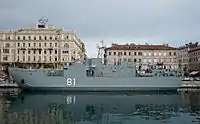
The Yugoslav Partisans captured several landing craft during the last stages of the Second World War. Among them were two former Italian MZ-type craft which were deleted by 1979 and a single ex-German MFP. An unknown number of Siebel ferrys was also commissioned. During the 1950s Yugoslav shipyards built a large number of landing craft based on German war designs designating them as DTMs (Desantni Tenkonosac-Minopolagač, tank landing craft-minelayer), DSMs (Desantna Splav-Minopolagač, landing craft-minelayer) and PDSs (Pomoćna Desantna Splav, auxiliary landing craft). Several of these craft were captured by the Croatians, but only PDS-713, DSM-110 and DTM-110 were commissioned with the Croatian Navy, with the fate of the remaining ones left over in Croatian, unknown.[30][13]
During the 1970s and 1980s the "Montmontaža Greben Shipyard" on the island of Korčula built a large number of Type 11 and Type 22 landing-assault craft intended for transporting troops and cargo. Although sharing a common design, the two types featured a different carrying capacity, propulsion system and weapons. The last class of landing ships to be commissioned with the Yugoslav Navy was the Silba-class landing ship-minelayers. At the start of the Croatian War of Independence one ship was in active service while another one was being built. Named Rab, the unfinished ship was captured by the Croatians, completed and commissioned with the Croatian Navy as Cetina (DBM-81).[17][40][13]
| Class | Image | Type | Boats | Shipyard | History | Fate |
|---|---|---|---|---|---|---|
| DJČ-601 DJČ-602 DJČ-603 DJČ-604 DJČ-605 DJČ-606 DJČ-607 DJČ-608 DJČ-609 DJČ-610 DJČ-611 DJČ-612 DJČ-613 DJČ-614 DJČ-615 DJČ-616 DJČ-617 DJČ-618 DJČ-619 DJČ-620 |
Montmontaža Greben, Vela Luka, SR Croatia[40] | Domestic design completed during the 1970s.[13] | 602, 603, 612, 613 and 615 captured by Croatian Forces and commissioned with the Croatian Navy. The rest were relocated to Montenegro[41][42][43] | |||
| DJČ-621 DJČ-622 DJČ-623 DJČ-624 DJČ-625 DJČ-626 DJČ-627 DJČ-628 DJČ-629 DJČ-630 DJČ-631 DJČ-632 |
Montmontaža Greben, Vela Luka, SR Croatia[40] | Completed during the 1980s; improved Type-11 with a larger carrying capacity.[40] | 623 and 624 captured by Croatian Forces and commissioned with the Croatian Navy.[41] According to the Naval Institute Guide to Combat Fleets of the World, three additional Type-22 of unknown designations were captured but weren't commissioned with the Navy. Conway's All the World's Fighting Ships states that 622 was also captured. The rest were relocated to Montenegro[41][30] | |||
| Krk (DBM-241) | Brodogradilište specijalnih objekata, Split, SR Croatia[17] | Completed in 1986[17] | Relocated to Montenegro.[44] |
Auxiliaries
Tugboats
| Class | Image | Type | Boats | Shipyard | History | Fate |
|---|---|---|---|---|---|---|
| LR-67 LR-68 LR-69 LR-70 LR-71 LR-72 LR-73 LR-74 |
LR-71 and LR-73 captured by Croatian forces and commissioned with the Croatian Navy under their existing designations. | |||||
| Coastal tugboat | PR-37 Tunj (PR-38) PR-39 PR-40 |
Tito's Kraljevica Shipyard, Kraljevica, SR Croatia (PR-38 and PR-39) | PR-38 completed in 1957 and PR-39 in 1958. | Relocated to Montenegro | ||
| Coastal tugboat | Orada (PR-41) | Tito's Shipyard Beograd, Belgrade, SR Serbia | Relocated to Montenegro |
Notes
- Library of Congress.
- Gardiner 1995, p. 641.
- Gardiner 1995, p. 642.
- Jelavić.
- Sušačka revija.
- UHDDR HRM.
- Gardiner 1980, p. 311.
- Tehnički muzej.
- Gardiner 1980, p. 358.
- Gardiner 1980, p. 310.
- Fontenoy 2007, p. 242.
- Gardiner 1995, p. 644.
- Gardiner 1995, p. 646.
- Heroj.
- Šoštarić & 7 August 2008.
- Sava.
- BSO.
- Gardiner 1995, p. 643.
- Freivogel.
- HMS Wager.
- Koni.
- Bernadić 2013.
- Kraljevica.
- uboat.net.
- Russian Ships.
- Wertheim 2007, p. 145.
- Gardiner 1980, p. 359.
- Gardiner 1995, p. 649.
- Osa.
- Wertheim 2007, p. 42.
- Gardiner 1995, p. 647.
- Fougueux.
- RD1.
- Gardiner 1980, p. 648.
- Gardiner 1995, p. 648.
- Marinkalender 1990.
- Saunders 2004, p. 653.
- Wertheim 2007, p. 147.
- Wertheim 2007, p. 148.
- Bernadić 2006.
- Kalajdžić & 16 April 2004.
References
Books
- Gardiner, Robert (1980). Conway's All the World's Fighting Ships 1922-1946. London: Conway Maritime Press. ISBN 0-85177-146-7.
- Gardiner, Robert (1995). Conway's All the World's Fighting Ships, 1947–1995. Annapolis, Maryland: Naval Institute Press. ISBN 978-0-85177-605-7.
- Fontenoy, Paul (2007). Submarines: An Illustrated History of Their Impact. Santa Barbara, California: ABC-CLIO. ISBN 978-1-85109-568-1. Retrieved 14 March 2014.
- Wertheim, Eric (2007). The Naval Institute Guide to Combat Fleets of the World, 15th Edition: Their Ships, Aircraft And Systems. Annapolis, Maryland: Naval Institute Press. ISBN 9781591149552.
- Saunders, Stephen (2004). Jane's Fighting Ships 2004–2005. Jane's Information Group Limited. ISBN 0-7106-2623-1. OL 7790644M.
News reports
- Šoštarić, Eduard (7 August 2008). "Bitka za jedrenjak 'Jadran'" [Battle for the sailboat 'Jadran']. Nacional. Archived from the original on 22 July 2012. Retrieved 31 January 2014.
- Bernadić, Stjepan (October 2013). "Oproštaj bez zvuka sirene" [Farewell without the sounds of sirens]. Hrvatski vojnik (in Croatian). Ministry of Defence (Croatia) (432). ISSN 1333-9036. Archived from the original on 2013-12-12.
- Bernadić, Stjepan (September 2006). "Prvi brod Hrvatske ratne mornarice" [First ship of the Croatian Navy]. Hrvatski Vojnik (in Croatian). Ministry of Defence (432). ISSN 1333-9036. Archived from the original on 2013-10-02.
- Kalajdžić, Ahmet (16 April 2004). "Kafići u utrobi ruzinave flote" [Caffés in the belly of a rusty fleet]. Slobodna Dalmacija. Retrieved 10 March 2014.
Other sources
- "HMS Mallow (K 81)". uboat.net. Retrieved 13 March 2014.
- "Imena ratnih brodova na prostoru bivše Jugoslavije" [Warship names in the former Yugoslavia]. Croatian war of Independence veterans society – Croatian Navy. Retrieved 13 March 2014.
- "Shipyard Kraljevica - List of delivered vessels 1946. - 2007" (PDF). Kraljevica Shipyard. Archived from the original (PDF) on 9 May 2009. Retrieved 13 March 2014.
- "Large torpedo boats – Project 206". russian-ships.info. Archived from the original on 12 May 2014. Retrieved 13 March 2014.
- "Ciclone torpedo boats / destroyer escorts". navypedia.org. Retrieved 13 March 2014.
- "Obnova džepne podmornice CB-20; ex. P-901 – Mališan" [Restoration of the midget submarine CB-20; ex. P-901 – Mališan]. Technical Museum, Zagreb. Retrieved 14 March 2014.
- "Podmorničarska tradicija na Hrvatskom Jadranu" [Submarine tradition on the Croatian Adriatic]. Sušačka revija. Retrieved 16 March 2014.
- "Yugoslavia – Naval Forces". Library of Congress. Retrieved 17 March 2014.
- Jelavić, Tino (December 2003). "Razmatranja o JNA" [Contemplations regarding the HNA]. Polemos. Croatian Sociological Association. VI (11–12): 163–175. Retrieved 17 March 2014.
- "Review of delivered vessels since 1980" (PDF). Brodogradilište specijalnih objekata. Archived from the original (PDF) on 13 March 2014. Retrieved 13 March 2014.
- "Heroj-class attack submarines" (PDF). Brodarski institut. Retrieved 29 March 2014.
- "Sava-class attack submarines" (PDF). Brodarski institut. Retrieved 29 March 2014.
- "PC 1615". fougueux.nl. Retrieved 1 April 2014.
- "HMS Kempenfelt (ii) (R 03) – W-class Flotilla Leader". naval-history.net. Retrieved 5 April 2014.
- "HMS Wager (R 98) – W-class Destroyer". naval-history.net. Retrieved 5 April 2014.
- "Guard ships - Project 1159". russian-ships.info. Archived from the original on 10 April 2012. Retrieved 6 April 2014.
- "Missile boats – Project 205". russian-ships.info. Archived from the original on 10 November 2013. Retrieved 16 April 2014.
- Freivogel, Zvonimir. "Scrapping of Various Warships". Warship International. Toledo, OH: International Naval Research Organization. XXXI (4): 428–29. ISSN 0043-0374.
- "RD1 group minesweepers". navypedia.org. Retrieved 17 April 2014.
